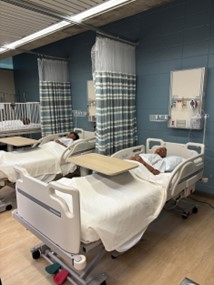Sep
13

Posted by Margot M on September 13th, 2024
Posted in: Funded Project
Tags: Boot Camp, nursing education, science librarians
Part of a blog post series from New England Science Boot Camp for Librarians scholarship recipients.

Logo for New England Science Boot Camp for Librarians
Logan Arrowood (Bowdoin College):
On Wednesday, June 26th, a group of attendees from the New England Science Boot Camp for Librarians assembled to tour the Elizabeth Pennington Simulation Laboratory and Debriefing Suite at the UMass Dartmouth College of Nursing and Health Sciences. On the tour, attendees viewed examination suites and simulation labs featuring fully functioning screening labs and hospital environments featuring low and high-fidelity mannequins. These highly sophisticated mannequins allow teachers to interact and create simulations that mirror what students could expect to experience in their future careers. By practicing care in simulated environments, nursing students can fully experience a range of challenging situations, from difficult patients to emergencies and patient death, that they may not experience in their student placements. By engaging with patients in simulated learning environments, students can learn how to best meet the needs of their patients and deliver high quality care that is both safe for students and patients.

Photo by Daniel Folk
Daniel Folk:
When I first arrived on the tour, I got to see my very first nursing simulation. From what I saw, I could tell that it was much like what I’ve seen in my years as a patient. We visited a total of two labs, one which was a large room with the practice fluids, needles, and mannequins dressed up like patients. These mannequins, while accurate anatomically, are not able to behave like patients, and remain immobile. I do appreciate that the mannequins would help the students to acclimatize themselves with working with live patients, all mocked up to be looking. Below is a picture of one of the mannequins.
We next moved to higher grade facilities, which held the mockup patients who were infants and children. In addition to being of more diverse types, these could also be controlled by some people in the room to simulate the more complex art of communicating with a patient while treating them. I was in awe of it. Unfortunately, I was not able to see the mannequins working and in progress, but we were able to move them around a bit. I found them to have a bit of an uncanny valley quality. I’m certainly glad that these were available for use to any nursing students, and it’s amazing what we can do with current technology.